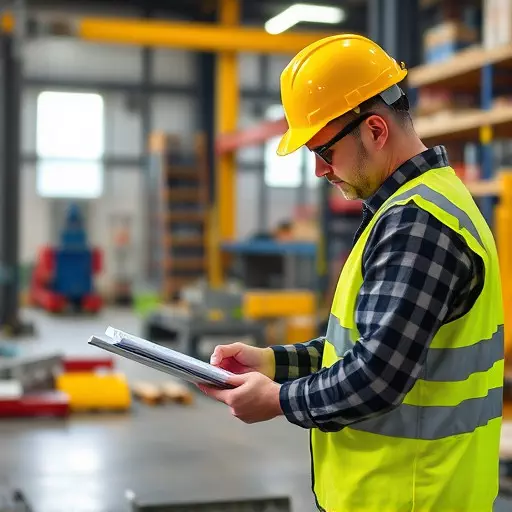Onsite Environmental Health and Safety (EHS) services are crucial for contractor safety management on construction sites. These services conduct comprehensive workplace safety audits, identifying physical hazards like falling objects, electrical risks, confined spaces, and hazardous substances. Through thorough hazard identification and risk assessment, EHS professionals prioritize issues based on likelihood and severity, then implement tailored strategies such as safety equipment, training, or adjusted work practices. Regular audits ensure continuous improvement in workplace safety standards, fostering a culture of prevention and compliance with industry best practices.
“In the dynamic realm of construction, ensuring contractor safety is paramount. This comprehensive guide explores the essential components of effective safety management, from foundational knowledge to advanced strategies. We delve into ‘onsite EHS services’, uncovering how hazard identification and risk assessment are pivotal in mitigating potential dangers. Furthermore, this article illuminates the significance of strategic workplace safety audits and shares best practices for continuous improvement throughout construction projects, ensuring a safer, more robust work environment.”
- Understanding Contractor Safety Management: The Foundation of Onsite EHS Services
- Hazard Identification: Unveiling Potential Dangers on Construction Sites
- Risk Assessment: Evaluating and Prioritizing Hazards for Effective Mitigation
- Implementing Workplace Safety Audits: A Strategic Approach to Contractor Safety
- Continuous Improvement: Best Practices for Enhancing Contractor Safety Throughout Projects
Understanding Contractor Safety Management: The Foundation of Onsite EHS Services

Contractor safety management is a critical component of any construction project, ensuring the well-being of all individuals involved. At its core, effective contractor safety management lies in the provision of onsite EHS services. These services encompass a range of activities designed to identify, mitigate, and prevent potential hazards and risks on the job site. By integrating comprehensive workplace safety audits into their practices, construction companies can identify not only physical dangers but also assess the effectiveness of existing safety protocols and procedures.
The process begins with thorough hazard identification, where EHS professionals meticulously scan every aspect of the work environment. This includes a detailed risk assessment to prioritize potential hazards based on likelihood and severity. Once identified, these hazards are addressed through tailored strategies that may involve implementing safety measures, providing specialized training, or adjusting work practices. Regular audits ensure that workplace safety standards remain up-to-date, reflecting evolving industry best practices and regulatory requirements.
Hazard Identification: Unveiling Potential Dangers on Construction Sites

Construction sites present unique challenges due to their dynamic nature and diverse tasks. Effective hazard identification is a cornerstone of contractor safety management. Onsite EHS (Environmental Health and Safety) services play a pivotal role in uncovering potential dangers that may be overlooked. Through comprehensive workplace safety audits, these services meticulously scan every aspect of the construction environment, from heavy machinery operations to material handling practices. By conducting thorough risk assessments, they identify hazards such as falling objects, electrical risks, confined spaces, and exposure to hazardous substances.
Regular hazard identification processes ensure that contractors are proactive in addressing safety concerns. It involves a detailed examination of work procedures, equipment conditions, and the overall site layout. This proactivity fosters a culture of workplace safety by empowering employees to recognize potential risks and take corrective actions. Additionally, it allows for the implementation of appropriate controls and safety measures tailored to the specific hazards identified on each project site.
Risk Assessment: Evaluating and Prioritizing Hazards for Effective Mitigation

Risk assessment is a cornerstone of effective contractor safety management. It involves a systematic process of identifying potential hazards present on the job site, evaluating their likelihood and severity, and implementing appropriate controls to mitigate risks. Onsite EHS services play a vital role in facilitating this process through comprehensive workplace safety audits. These audits meticulously scan the work environment, focusing on hazard identification and risk assessment, to uncover potential dangers that may be overlooked.
By prioritizing hazards based on their potential impact, workplace safety audits enable contractors to strategically allocate resources for risk mitigation. This proactive approach ensures that safety measures are tailored to address the most pressing concerns, enhancing overall workplace safety. Regular audits also foster a culture of continuous improvement by encouraging ongoing monitoring and adaptation to evolving work conditions and industry standards.
Implementing Workplace Safety Audits: A Strategic Approach to Contractor Safety

Implementing workplace safety audits is a strategic approach to contractor safety, enabling organizations to proactively identify and mitigate potential hazards. Onsite EHS services play a crucial role in conducting thorough audits that encompass hazard identification and risk assessment. By regularly evaluating work environments, these services help uncover hidden dangers and ensure compliance with safety regulations.
Through systematic inspections, onsite EHS professionals can pinpoint areas where contractors may be at risk, from inadequate personal protective equipment to unsafe machinery operations. This data-driven approach allows for informed decisions to be made, leading to the implementation of effective safety measures that foster a culture of prevention among contractors.
Continuous Improvement: Best Practices for Enhancing Contractor Safety Throughout Projects

Contractor safety management is a dynamic process that requires continuous improvement to stay ahead of evolving workplace hazards. One of the best practices for enhancing contractor safety throughout projects involves regular onsite EHS (Environmental Health and Safety) services. These services include comprehensive workplace safety audits, which identify potential risks and areas for improvement. By conducting these audits at various stages of a project, companies can ensure that safety protocols are not only in place but also effectively implemented and maintained.
Additionally, hazard identification and risk assessment play a crucial role in continuous improvement. Effective identification of hazards allows for thorough risk assessments, enabling proactive measures to mitigate potential accidents or injuries. This process involves engaging contractors, reviewing historical data, and conducting regular inspections to anticipate and address safety challenges before they escalate. Such practices foster a culture of safety and contribute to the overall success and sustainability of construction projects.


